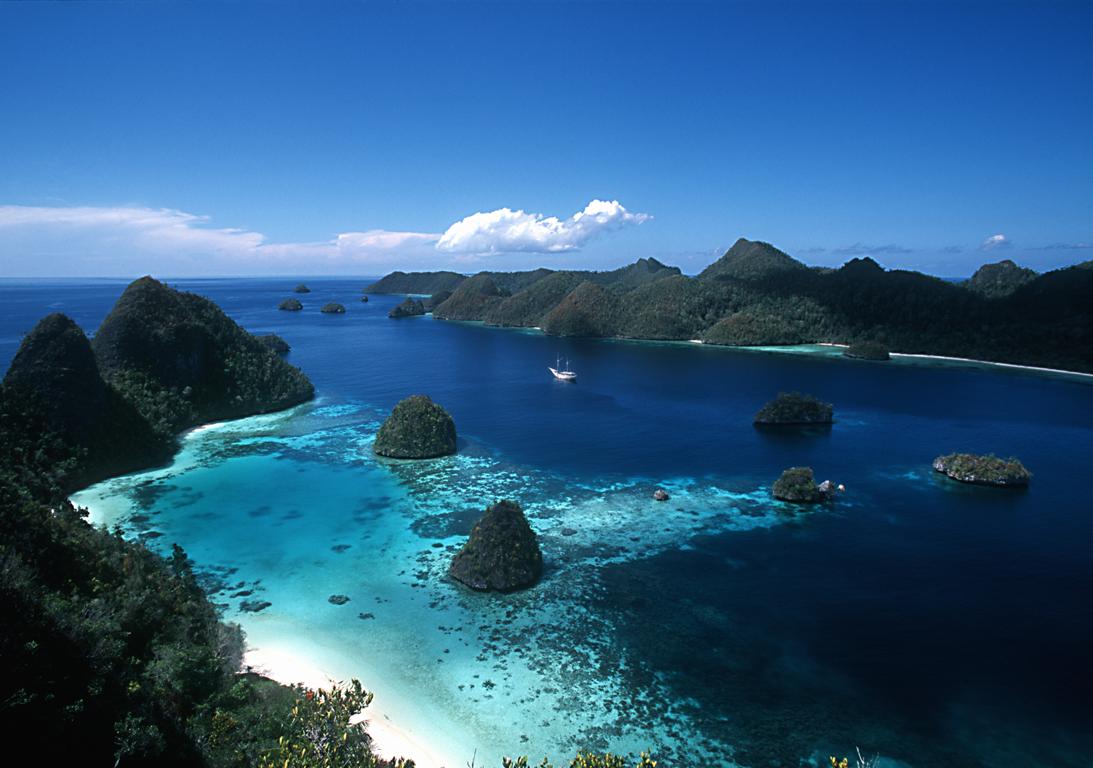
The Raja Ampat Island in Irian is group spreads out over a huge area and consists of over 610 islands. The four largest islands are Waigeo, Batanta, Salawati and Misool. The area's reefs are covered in a diverse selection of both hard and soft corals.
Most of the areas reefs are pristine, with mile after mile of perfect hard corals, drift after drift of soft corals of many species and colors ranging from brilliant red, to shocking yellow pretty pink and exotic purple. Most reef dives are very colorful. The tourist would be able to experience the best dives sites within those islands, which include Cape Kri, Mellisa's Garden, Sardines Reef, The Passage, Nudibranch Rock, Wai Island Night Dive.

According to Concervation International, marine surveys suggest that the marine life diversity in the Raja Ampat area is the highest recorded on Earth. Diversity is considerably greater than any other area sampled in the Coral Triangle composed of Indonesia, Phillipines and Papua New Guinea. The Coral Triangle is the heart of the world's coral reef biodiversity, making Raja Ampat quite possibly the richest coral reef ecosystems in the world.
The area's massive coral colonies along with relatively high sea surface temperatures, also suggest that its reefs may be relatively resistant to threats like coral bleaching and coral disease, which now jeopardize the survival of other coral ecosystems around the world. The Raja Ampat islands are remote and relatively undisturbed by humans.
The high marine diversity in Raja Ampat is strongly influenced by its position between the Indian and Pacific Oceans, as coral and fish larvae are more easily shared between the two oceans. Raja Ampat's coral diversity, resilience, and role as a source for larval dispersal make it a global priority for marine protection.

Over 1,070 fish species, 537 coral species (a remarkable 96% of all scelactrinia recorded from Indonesia are likely to occur in these islands), and 699 mollusk species, the variety of marine life is staggering.Some areas boast enormous schools of fish and regular sightings of sharks, such as wobbegongs.
For the fauna sector, Raja Ampat has rarely fauna, such as; red birds of paradise (Paradise Rubra), Wilson birds of paradise (Cicinnurs Republica), Maleo Waigeo (Spilocuscus Papuensis), and rainbow fishes. Hence, for the flora, Raja Ampat has many kinds of Orchids, Waigeo palm, ironwoods or black woods, 'keruing', 'ulin' woods, etc.
Because of its various nature profit, Raja Ampat will declared by Maritime Ministry Freddy Numberi as ancient regency, based on its location that not only rich of fishes, but also its sea herb and the pearl.
Most of the areas reefs are pristine, with mile after mile of perfect hard corals, drift after drift of soft corals of many species and colors ranging from brilliant red, to shocking yellow pretty pink and exotic purple. Most reef dives are very colorful. The tourist would be able to experience the best dives sites within those islands, which include Cape Kri, Mellisa's Garden, Sardines Reef, The Passage, Nudibranch Rock, Wai Island Night Dive.

According to Concervation International, marine surveys suggest that the marine life diversity in the Raja Ampat area is the highest recorded on Earth. Diversity is considerably greater than any other area sampled in the Coral Triangle composed of Indonesia, Phillipines and Papua New Guinea. The Coral Triangle is the heart of the world's coral reef biodiversity, making Raja Ampat quite possibly the richest coral reef ecosystems in the world.
The area's massive coral colonies along with relatively high sea surface temperatures, also suggest that its reefs may be relatively resistant to threats like coral bleaching and coral disease, which now jeopardize the survival of other coral ecosystems around the world. The Raja Ampat islands are remote and relatively undisturbed by humans.
The high marine diversity in Raja Ampat is strongly influenced by its position between the Indian and Pacific Oceans, as coral and fish larvae are more easily shared between the two oceans. Raja Ampat's coral diversity, resilience, and role as a source for larval dispersal make it a global priority for marine protection.

Over 1,070 fish species, 537 coral species (a remarkable 96% of all scelactrinia recorded from Indonesia are likely to occur in these islands), and 699 mollusk species, the variety of marine life is staggering.Some areas boast enormous schools of fish and regular sightings of sharks, such as wobbegongs.
For the fauna sector, Raja Ampat has rarely fauna, such as; red birds of paradise (Paradise Rubra), Wilson birds of paradise (Cicinnurs Republica), Maleo Waigeo (Spilocuscus Papuensis), and rainbow fishes. Hence, for the flora, Raja Ampat has many kinds of Orchids, Waigeo palm, ironwoods or black woods, 'keruing', 'ulin' woods, etc.
Because of its various nature profit, Raja Ampat will declared by Maritime Ministry Freddy Numberi as ancient regency, based on its location that not only rich of fishes, but also its sea herb and the pearl.


No comments:
Post a Comment